Eric Zweig's Blog, page 19
November 2, 2016
Tuning In Over Time
Game Seven of the World Series. As classic phrases go, it doesn’t get much better than that! I don’t really have a favorite in this one, but it’s hard not to be rooting for the Cubs. Still, if they do win it, it’ll certainly be tough not to feel bad for fans in Cleveland.
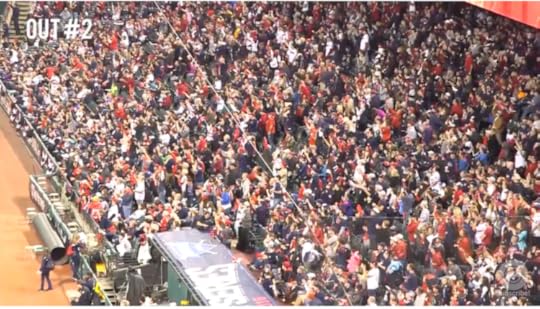
These fans in Cleveland are reacting to the game played in Chicago.
The Indians drew more than 67,000 fans to Progressive Field for games three, four and five of the series … which were played at Wrigley Field in Chicago! These fans paid $5 for a ticket (proceeds going to local charities) to watch the game on the giant video board. This has become something of a thing in recent years, but fans have been gathering to follow their teams on the road like this for more than a century!
When the Winnipeg Victorias hockey team traveled to Montreal to play their Victorias for the Stanley Cup in February of 1896, telegraph wires were run to local hotels so that Winnipeg fans could receive play-by-play updates during the game. Soon, fans all across Canada were showing up at train stations or outside of newspaper offices to “listen in” on these telegraphed reports. As early as 1907, fans gathered inside the rink in Kenora, Ontario, to receive updates from Montreal as the Thistles battled the Wanderers for the Stanley Cup.
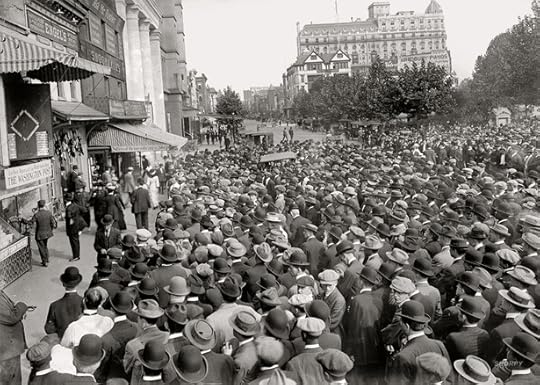
Fans gather in the street to follow the World Series.
Baseball has similar traditions, with a history of elaborate electronic scoreboard devices set up in American cities to follow the action of the World Series. Often, these devices drew big crowds in the streets outside of newspaper offices, but there were also set ups in theaters, armories, and other reception halls.

Ads in the New York Times in 1915.
Perhaps it’s just me, but I find it amazing how much the Gameday display on the web site for Major League Baseball…
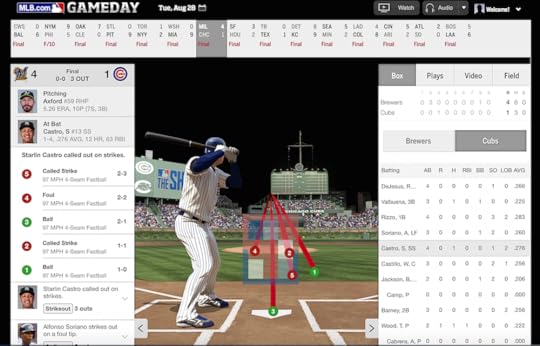
looks like one of those old-fashion scoreboard machines…
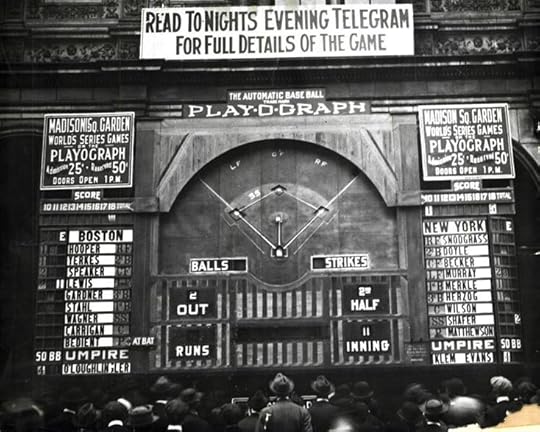
My favorite of these old-time devices is something call the Jackson Manikin Baseball Indicator. It was like a giant arcade game which used mechanical men to re-enact each play in a game as it was received via telegraph. For more on this one, you can see a story I wrote a few years ago for the Society for American Baseball Research.
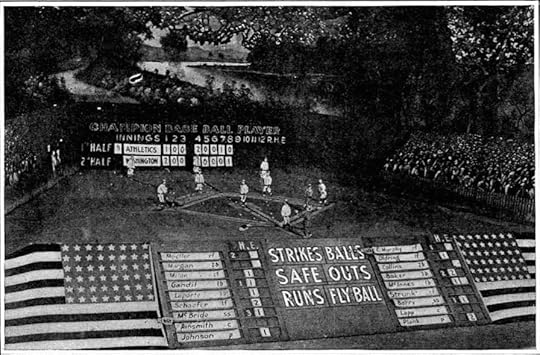
The Jackson Manikin Baseball Indicator, circa 1913.
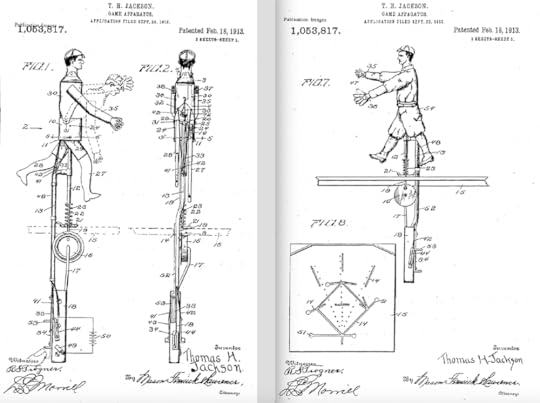
Details of the Manikins from Thomas Jackson’s patent application.
And during the 1926 Junior World Series when the Toronto Maple Leafs defeated the Louisville Colonels, fans in Louisville had a unique way of following the action when their team was in Toronto.

From The Globe in Toronto, October 5, 1926.
So, as it so often seems to be, the more things change, they more they stay the same!
October 25, 2016
It Only Feels Like Forever!
Well, I’d still like to have seen the Blue Jays in it, but fans in Chicago and Cleveland have been waiting for a World Series championship a lot longer than Toronto baseball fans, who haven’t seen a title since 1993. Their droughts make even the Toronto Maple Leafs’ last Stanley Cup win in 1967 seem pretty recent!
Cleveland just got to celebrate the Cavaliers’ NBA championship, and the city’s first of any kind since 1964, but they haven’t seen their baseball team win the World Series since 1948. And even that, of course, pales in comparison to the mother of all championship droughts. The Chicago Cubs haven’t even been to the World Series since 1945, and they haven’t won it since their back-to-back titles in 1907 and 1908! Both wins came over the Detroit Tigers.
Not surprisingly, some of the coverage of those Cubs wins looks a little bit different than what we’re used to today…
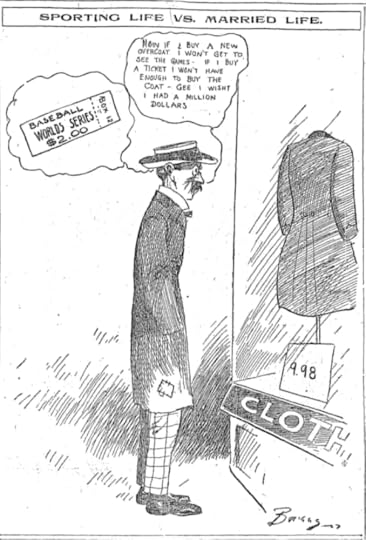
From the Chicago Tribune on October 6, 1907. Prices go up, but the
dilemma remains.
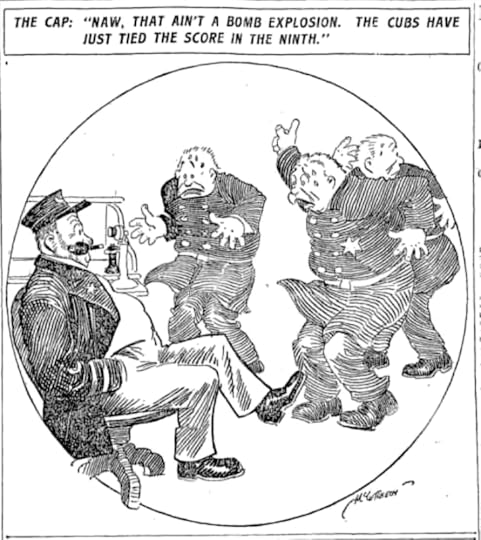
Cubs fans roared when their team scored two in the bottom of the ninth
to tie Game 1 at 3-3 on October 8, 1907 as depicted in the Tribune the
next day. The game was called after 12 innings, still tied 3-3.

Because of the tie game, it took five for the Cubs to sweep the Detroit Tigers in 1907.
This cartoon appeared in the Tribune on October 13, 1907.

A year and a day later, October 14, 1908, the Tribune commemorated
the previous day’s 3-0 victory of Mordecai “Three Finger” Brown that
gave Chicago a 3-1 lead over Detroit in the 1908 Series.

The Cubs then made it two in a row, as noted in the Tribune on October 15, 1908.
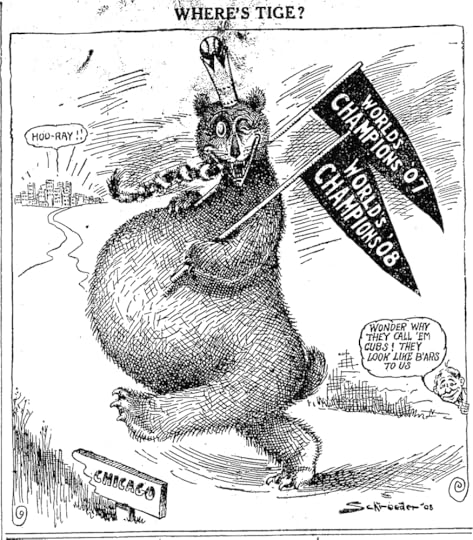
And in the Detroit Free Press the same day.
October 18, 2016
An Ace Of An Idea!
As you likely know by now, the Maple Leafs’ lavish ceremony on Saturday night to open the 100th season of NHL hockey in Toronto was a huge success. After years of choosing to “honour” players numbers but keep them in circulation, the team announced it would retire those numbers – as every other team in sports does for its greatest franchise heroes.
What Dave Keon had long perceived as this lack of proper recognition is what had kept him away from the team for so long, rather than any lingering resentment over his feud with Harold Ballard. Now Keon is back, and while I might quibble with his selection as the number-one player in Leafs history, his number 14 has taken its rightful place among the rest of the team’s greats.
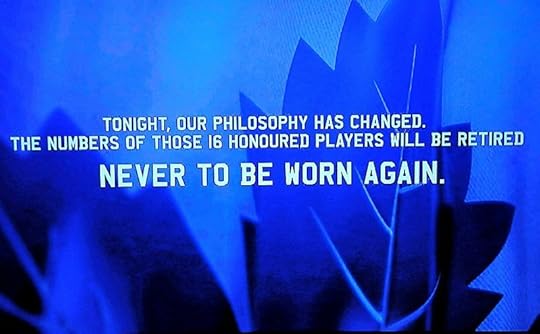
In the past, the Leafs had only retired the numbers of Bill Barilko (5), who was famously killed in a plane crash after scoring the Stanley Cup-winning goal in 1951, and Ace Bailey (6) whose career ended in 1933 when he fractured his skull after being knocked to the ice by Boston’s Eddie Shore. Even so, James van Riemsdyk was the only current Leaf wearing one of these newly retired numbers, and he gladly gave up Borje Salming’s now-retired 21 and took 25.
Team president Brendan Shanahan had something very interesting to say when asked about the decision to change the Leafs’ policy regarding retired numbers. “When you asked questions, people really didn’t have a reason why we [weren’t doing it]. I like the story of players handing numbers down … to another player. But I don’t remember Borje Salming handing a sweater to JVR. It wasn’t happening. It’s a great story. But if you’re not doing it, then let’s do the right thing.”
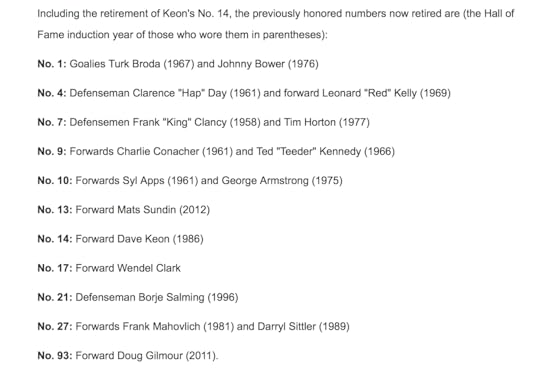
I have read accounts from Teeder Kennedy saying how pleased he was when he was given the number of his hero Charlie Conacher, and I know that Darryl Sittler has talked about his belief that the team had big plans for him because he was given Frank Mahovlich’s #27. But the only Leafs story I’m aware of where a player literally handed his former number to a current player was when Ace Bailey requested that Ron Ellis be given his #6.
Bailey handed his number to Ellis in a ceremony at the Hot Stove Lounge at Maple Leaf Gardens on September 24, 1968. “My family and I wanted to see somebody wear the number while I was still active in hockey,” said Bailey, who was a timekeeper at the Gardens. “Ron is a real hockey player who never gives his club any trouble. I think he’ll be an all-star in years to come.
“This number is two digits lighter than your old number,” Bailey joked to Ellis, who had worn #8 since his junior days, “so you should go a little faster.”
“I’ll wear this sweater with a great deal of pride,” Ellis told him.
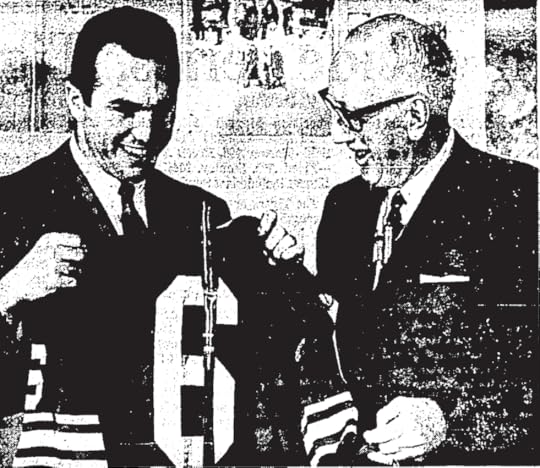
But as the Toronto Star noted the following day, Ace Bailey handed a #6 sweater to Ron Ellis, but not the #6 sweater. Bailey had kept his retired jersey for nearly 30 years, but it had recently been discovered that it was missing!
Bailey had loaned his sweater to the Hockey Hall of Fame about seven years earlier, but a short time later the Maple Leafs asked the Hall if they could have it and Barilko’s #5 sweater for a display at Maple Leaf Gardens. Gardens officials swore they had returned it, but the Hall of Fame’s new curator Lefty Reid was “99 percent sure it was not in the building.”
Speculation was that Bailey’s sweater may have been destroyed a few years earlier when a drain backed up at the Hall of Fame building and flooded some storage rooms, or that a workman might have made off with it during recent renovations there.
“If anyone has seen a blue hockey sweater, 1933 vintage, with a white Maple Leaf on the front and the number 6 on the back,” wrote Jim Crerar in the Star, “please contact Lefty Reid at the Hockey Hall of Fame immediately.”
I don’t believe the sweater has ever turned up.
October 13, 2016
Great Start … But Is It A Record?
Toronto Maple Leafs rookie Austin Matthews scored four goals last night in his first NHL game. It’s pretty amazing! (Although marred somewhat by Toronto’s 5-4 loss in overtime to Ottawa.) So, was it an NHL record? That’s not as straightforward as you may think!
The confusion probably goes back to the 1979-80 season when the NHL didn’t want to consider Wayne Gretzky a rookie because of his one year as a professional the season before in the World Hockey Association. Gretzky had 51 goals, 86 assists, and 137 points that season. His 51 goals would have been two short of Mike Bossy’s then-rookie record of 53 … but his 86 assists and 137 points should have been records. They still should be, but instead, you’ll see those ROOKIE records are held by Peter Stastny, Joe Juneau (70 assists) and Teemu Selanne (132 points).
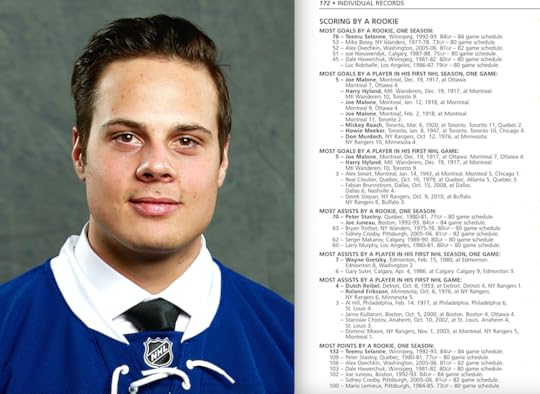
The records Gretzky is credited with for the 1979–80 season are all records for A PLAYER IN HIS FIRST NHL SEASON … but not rookie records. It can certainly get a bit confusing!
For years, the NHL listed the record for most goals by A PLAYER IN HIS FIRST NHL GAME as 3, first by Alex Smart in 1943, and then, more recently, by Real Cloutier, Fabian Brunnstrom and Derek Stepan. Unfortunately, I don’t have NHL Guide’s going back far enough, but my guess would be that before Cloutier (who, like Gretzky — but with even more years — was a WHA veteran) this was actually listed as a rookie record, but ever since I’ve been working on the Guide the wording has stated FIRST GAME and not ROOKIE.
There has also been a record for MOST GOALS BY A PLAYER IN HIS FIRST NHL SEASON, ONE GAME that for years was shared by Howie Meeker and Don Murdoch. But then, beginning with the NHL Official Guide & Record Book for 2010-11, we added the much older five-goal games by Joe Malone, Harry Hyland and Mickey Roach during their first NHL seasons. Since Malone and Hyland had both scored 5 goals in the two games played on the very first night in NHL history back on December 19, 1917, we had to add them to the record for most goals by a player in his first NHL game as well. Given that the rule book already had a distinction between rookies and first-year players, how could we not?
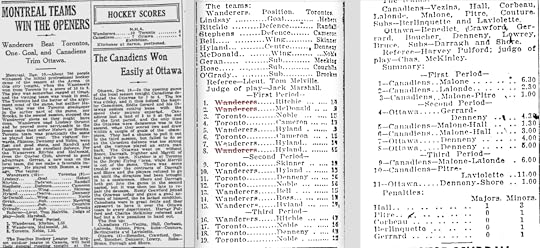
Stories from The Toronto World, December 20, 1917.
Summaries from the Toronto Star of the same date.
Malone and Hyland had both been pros, playing in the highest leagues of their day, since 1908. So, it’s certainly hard to consider them NHL “rookies” in 1917-18. Still, given that it was the league’s first season, there’s no denying that they each scored five goals in their first NHL games.
So, technically, while Auston Matthews seems to have set a rookie record last night, it’s not a record for a player in his first NHL game. But it’s still a pretty impressive debut! And if you check the summary above, you’ll note that Reg Noble scored four goals for Toronto against the Wanderers in that December 19, 1917 game. So, it looks like we’ll need to add that to the list along with Matthews for next year.
October 5, 2016
It Could Have Been Worse
Winning last night certainly takes a lot of the sting out of it! I still can’t explain the hitting woes (except that I think we’ll find out that Josh Donaldson has been hurt worse than they’ve let on), but before you go saying what a horrible collapse the Blue Jays had this September, consider this. At no point during the 2016 season did Toronto ever have more than a 2-game lead in the American League East – and they only led by that much for four days. Four! They only led the division at all for 32 days during the entire season. That’s basically one month out of six.
Now, admittedly, the Jays did hold that 2-game lead from August 28 through August 31, and 29 of their 32 games in first came after July 30. Obviously, that makes their September slide feel all the more painful. But even if they hadn’t won last night, I really think it seems a lot worse than it actually was.
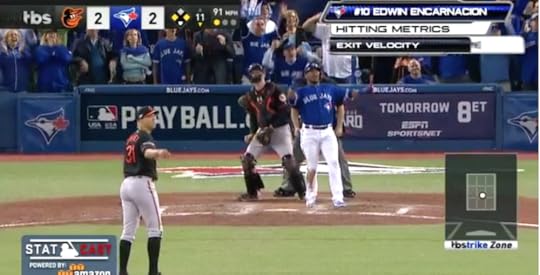
Edwin Encarnacion reacts to his game-winning three-run blast in the 11th inning.
Not convinced? Well, consider this. The Jays spent 111 days in either second or third place this year. That’s three times more time than they spent in first. And, really, they were never more than about 5 games from falling completely out of the playoff picture. So, hanging on for that home wild card berth was probably where they should have ended up anyway.
Since the two-team wild card format was introduced in 2012, I’ve always wondered how much qualifying for that wild card game would really feel like making the playoffs. Well, having gone through it now, I think it really does … and I’m not saying this just because we won! Still, it does seems strange to have the fate of an entire season come down to a single game. The baseball season has always been a marathon, not a sprint. But then again, it’s not like this never happened before the advent of the wild card.
Back in 1908 – the last time the Chicago Cubs won the World Series! – the fate of the National League season came down to just one postseason game. It wasn’t actually a playoff. It was a makeup game made necessary by the fact that the Cubs and the New York Giants had finished the season tied in first place and now had to replay a tie game from a few days earlier, on September 23, 1908.
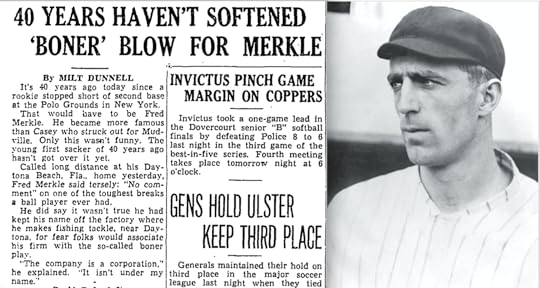
Milt Dunnell of the Toronto Star didn’t get much out of Fred Merkle even 40 years later.
Even now, 108 years later, that tie game is one of the most famous in baseball history. If you don’t already know the story, in a nutshell, the Giants should have won that day with a walk-off single in the bottom of the ninth, but the baserunner on first base, 19-year-old rookie Fred Merkle, never touched second. When the Cubs made a play to force him out, the ruling was made that the Giants apparent winning run didn’t count. For plenty more, you can Google Fred Merkle, or watch this clip of Keith Olbermann from 2013.
Merkle was dubbed “Bonehead” for his baserunning blunder and after the Giants lost the makeup game on October 8, 1908, his so-called “boner” would literally haunt him until his dying day. And beyond, really, because anyone who knows his name today is likely to know it because of that play.

A sample of some of the headlines that appeared above his obituary in
newspapers across North America the day after Fred Merkle died on March 2, 1956.
You may have heard Sandy Koufax recently, lauding Vin Scully and telling about how when Scully was covering the Dodgers in the World Series, he would say a prayer before it got started. Scully didn’t pray for the Dodgers to win, but for no one to make the type of mistake that would live on in infamy. No doubt Vin Scully had Fred Merkle in mind.
September 29, 2016
Canada’s Cup, But…
I like the chances of Team Canada wrapping up the World Cup of Hockey tonight in game two of the best-of-three final against Team Europe. I don’t mean to get ahead of things, but with gold medal wins at three of the last four Winter Olympics, and even at the last two World Championships (where we don’t get to play our best on best), Canadian men, as Wayne Gretzky said the other day, “seem to be getting better and strong.”
“Canada’s been Canada,” Gretzky said of the team’s performance at the World Cup. “We’ve been as good as we’ve ever been. We sell our sport worldwide, the game is getting bigger all the time, each and every year, but we seem to be getting better and better in our own country.”
“Everybody gets nervous and scared, are we losing our game? We’re never going to lose our game. It’s Canada’s game. I am just so impressed by how much depth and how many good players we have in this country.”
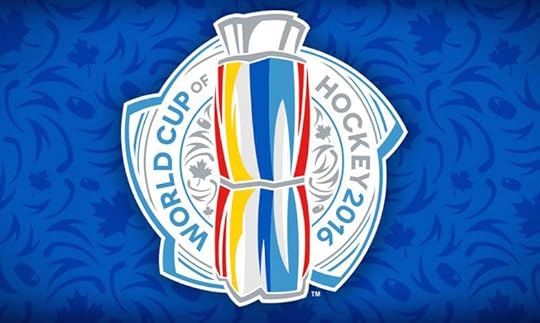
One big advantage we still have over all the other hockey countries – even those with much bigger populations than ours – is that (with the possible exception of Latvia) we’re the only country in the world where the majority of the top athletes want to play hockey. Perhaps the biggest threat to that going forward will be the crazy-high costs of the game forcing more and more of those top athletes to choose less expensive games like basketball and soccer. Global warming probably isn’t going to help either.
In the meantime, while it’s nice to be the best in the world at the sport we care about the most, winning global titles isn’t the only thing that make Canada’s game Canadian. It won’t stop people from worrying about the Americans taking over the NHL. Not when so many decisions coming out on the NHL head office in New York can appear to Canadians to be based solely (soullessly!) on business rather than a love of the game … like when the NHL chooses to place its next expansion team in Las Vegas instead of Quebec City, or when it never seems to consider Hamilton – although that probably has as much to do with the influence of the Toronto Maple Leafs as it does with an unpopular American NHL Commissioner.
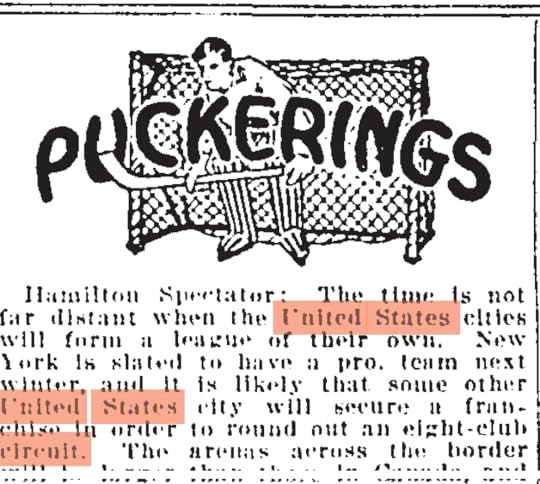
One of the earliest warnings of a U.S. takeover of the NHL came in a Hamilton Spectator
story picked up by Toronto’s Globe newspaper on December 12, 1924.
When Las Vegas comes on board in 2017-18, that’ll make 24 U.S.-based teams to only seven in Canada. And before that, when the spring of 2017 comes around, we’re likely to hear plenty once again about how no Canadian team has won the Stanley Cup since 1993. And remember, not a single one of those seven Canadian teams even reached the playoffs last year! Of course the NHL is big business, but things like this hardly make hockey feel like Canada’s game.
But fear not! With the NHL gearing up to celebrate the 100th anniversary of its 1917 founding, it turns out that worrying about Americans taking over our game dates back almost as long as that. With Boston having just become the first U.S. entry in the NHL, one of the first voices of concern was sounded by the Hamilton Spectator in December of 1924. The newspaper warned that, with more American teams to come, “[t]he arenas across the border will be bigger than those in Canada, and the admission charges will be higher, which means that the United States magnates will be in a position to get the pick of the players.”

The Globe expressed Canadian fears with stories such as this one on September 26, 1925, although the story notes that it may be a while before the U.S. could produce enough good players. It also warns that a salary cap may be necessary to save Canadian teams.
New York would get its NHL franchise with the admission of the Americans – at the expense of Hamilton losing its Tigers! – in 1925-26, and the NHL would add a team in Pittsburgh that year too. Canadians were definitely starting to worry about a U.S. takeover, and The Globe in Toronto became the lead voice of that fear. On January 22, 1926, Sports Editor Frederick Wilson warned that Canadian cities could become nothing more than an afterthought as the NHL expanded into more and more populous U.S. cities with “their fat bank-rolls.” Canadian teams would be forced to sell out to American owners, leading to predictions of All-American leagues with cities like Toronto, Montreal, Ottawa, and others banding together to become little more than all-Canadian minor leagues.

Conn Smythe used stories like this one on November 20, 1926, to convince the owners of the Toronto St. Pats to sell the team to his group. He would rename the team the Maple Leafs.
Fears became even worse when the New York Rangers, Detroit Cougars (later the Red Wings) and Chicago Blackhawks entered the NHL in 1926-27. The NHL was now a 10-team circuit with six of those clubs in the United States. Canada would never again have the majority of NHL teams, yet all these years later, it’s still our game … although it would be nice to see the Stanley Cup paraded through the streets of a Canadian city some time soon!
September 22, 2016
Frank McGee R.I.P.
One hundred years ago tomorrow, on September 23, 1916, word reached his family in Ottawa that the greatest hockey player of his day had been Killed in Action in World War I. Frank McGee had died in fighting at Courcelette in France, one week earlier, on September 16, 1916.

The newspaper story is from The Ottawa Journal on
September 23, 1916, confirming the death of Frank McGee.
McGee had left instructions that in case of casualty, his brother D’Arcy should be notified rather than his father, whom he’d listed as his next of kin. Rumours had begun to circulate on Friday, September 22, that McGee had died and D’Arcy McGee received confirmation that it was true while in his home at 12 Marlborough Avenue in Ottawa’s Sandy Hill District on Saturday. Another brother, Charles, had been been killed in the spring of 1915. A younger brother, Walter, would be shot through the shoulder in November, but he would survive the war.
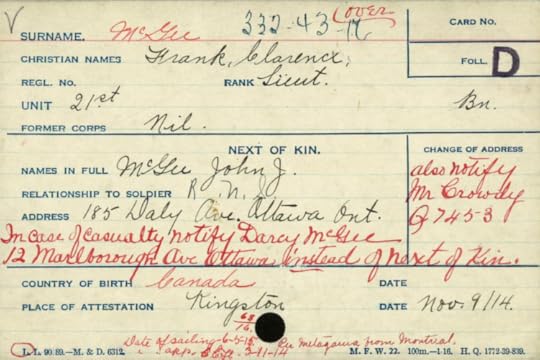
From the war records of Frank McGee available on the Library and Archives Canada web site.
Frank McGee was one of thousands of Canadian casualties during the Battle of the Somme. His death hit his hometown, where he’d starred for the legendary “Silver Seven,” particularly hard.
“[O]nce again there has been brought home with gripping grief and pain the grim reality of the present conflict of nations,” reads a story in the Ottawa Citizen. “It is doubtful if the loss of any one of the splendid young Ottawans who have fallen at the front since the outbreak of war has occasioned such keen regret as that of the late Lt. Frank McGee … Frank McGee dead? Thousands of Ottawans knew him. Few seemed able to believe that he too had given up his life in the struggle for freedom.”
Frank McGee had a brief career at hockey’s highest level, playing only a handful of games over four short seasons from 1902-03 to 1905-06. But his Ottawa team won the Stanley Cup in each of those years (although lost it before the 1905-06 season ended) and he averaged nearly three goals per game during that time. He is best remembered today for scoring 14 goals in Ottawa’s 23-2 win over Dawson City in a Stanley Cup game on January 16, 1905.
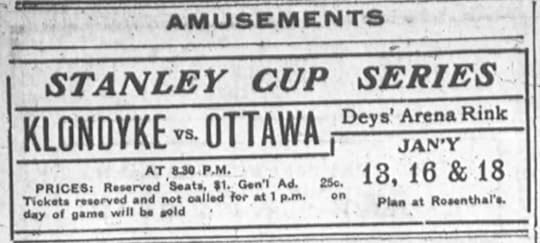
An ad in The Ottawa Journal showing dates and ticket
prices for the 1905 Stanley Cup series with Dawson City.
McGee accomplished all that he did despite having been blinded in one eye when he was struck by a stick (or maybe a puck) in 1900. According to a story in The Ottawa Journal on the twentieth anniversary of his death, the injury had not caused the removal of his eye, but McGee’s vision was impaired to the extent that he could only distinguish between light and darkness with it. It didn’t seem to slow him down on the ice, but it should have been enough to keep him out of the army. So how did he get in?
The most common story that’s told today is that when he was taking his medical exam and was asked to read the chart on the wall, McGee covered his left eye with his left hand and then, when asked to read with his left eye, raised his right hand, crossed his face, and covered the same left eye again.

However McGee got himself into the army, the medical officer who examined
him appears to have left the description of the vision in his left eye blank.
But the story being told up until 1936 was quite a bit different then the modern one. Back then, it was generally accepted as authentic that McGee had a friend who looked quite a bit like him take the eye exam for him. But D’Arcy McGee told a very different story to The Ottawa Journal for its anniversary story. D’Arcy admitted that because of his eye, Frank was nervous about his physical … but then the medical officer asked him his name.
“Frank McGee.”
“Not Frank McGee of the Silver Seven?”
“Yes, sir.”
“There can’t be anything wrong with you!”
The doctor laughed, giving McGee an admiring pat on the chest and passing him for the army.
The story of Frank McGee is one of the first tales of early hockey I can remember learning. I’m pretty sure I heard it for the first time on an episode of Peter Puck. This past year, I had the opportunity to tell parts of McGee’s story myself by contributing segments to two new books that are out this fall.
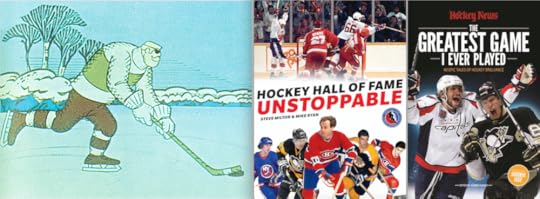
Though he was actually quite small, Frank McGee was depicted as a hulking giant
with an eye patch in the Peter Puck episode. And if you care to, you can check out
the books I contributed to for Firefly and The Hockey News.
September 14, 2016
Reggie and Me…
I’m sure I’ll get into the World Cup of Hockey when it starts up for real in a few days. But September is for baseball and pennant races! Of course I wish that the Blue Jays were doing better than 3-and-8 this month, but I’m trying to remember that for years (decades!) before last season, all I wanted was meaningful games in September. And, well, we’ve certainly got that now.
I was at the Blue Jays-Red Sox game on Saturday (the good one, that we won 3-2) with my two brothers and my nephew. Jorey is 13 now, and pretty much exactly like his father and uncles were at that age. At one point during the game, he wondered if any of us knew who was likely to be the next player to reach 3,000 career hits early next season. We didn’t.
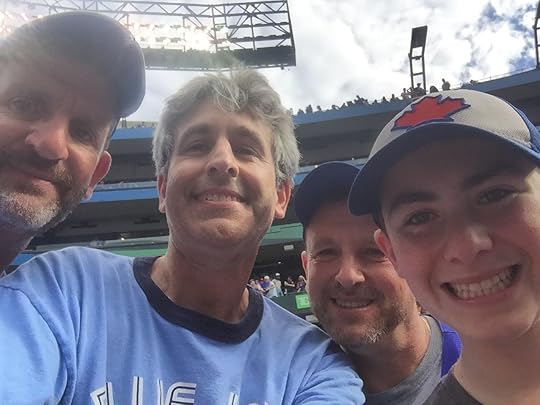
Once upon a time, I’m sure I would have known that immediately. These days, of course, I could look it up with a few taps and swipes on my phone (which I’ve since done – though on my laptop). It’s funny how, now that it’s so easy to know this stuff if you want to, I don’t know it anymore. Back in the old days, when I had to study the all-time lists in the annual preseason Street & Smith’s Baseball Magazine and then, basically, keep it in my head all season, I pretty much did. Now I don’t.
So, any idea who, as of last night’s game, got his 2,926th hit (and 443 home run, by the way)? I’ll put the answer in at the bottom of this story … and I’ll be curious to hear from anybody who can tell me they honestly knew it without looking it up!
Jorey also asked us who, in 40 seasons as Blue Jays fans, is the greatest player we’ve ever seen. We threw out a lot of names, and then finally decided it was probably Ken Griffey Jr. But good as he was, Griffey never really won anything. So I was wondering if, maybe, given all he did on the largest stage, the greatest player was Reggie Jackson. All those “Mr. October” moments definitely made an impression on me when I was Jorey’s age.
That being said, I never liked Reggie Jackson. (I know I’m not alone there.) He was just too pompous and arrogant. But I do have one good Reggie Jackson story from my days on the Blue Jays ground crew.
During the early summer of 1983, when the Jays were first becoming contenders, the California Angels were in town. On this Saturday (June 18), Jim Clancy had pitched seven strong innings but surrendered our tight, 3-2 lead when he gave up back-to-back doubles leading off the top of the eighth. Joey McLaughlin came in, put a couple more guys on, but got out of trouble. The Jays then took back the lead with three runs in the bottom of the eighth, highlighted by a two-run home run from Lloyd Moseby.
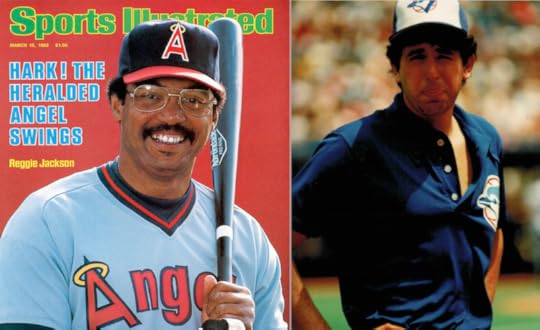
But the Angels weren’t done. Bobby Grich led off the ninth with a homer and then, with two out, Rod Carew and Juan Beniquez singled, bringing Reggie Jackson to the plate. Bobby Cox went to the bullpen for a lefty – rookie Stan Clarke, who’d made his Major League debut just 11 days before. Clarke quickly jumped ahead 0-2.
“I wanted that situation bad,” Clarke told reporters after the game. “I wanted to strike him out. That’s all I wanted to do.”
In my memory, you could literally see Clarke shaking with the excitement of it. Almost laughing that he’d actually gotten Reggie Jackson to foul off a couple of pitches and was going to strike him out and save the game.
“I stepped back off the mound, and I told myself: ‘Relax and throw your best pitch.’ But it didn’t work out that way.”
Reggie slugged the next pitch for a three-run homer, and glared at Clarke as he rounded the bases. He’d seen the young lefty shaking too.
“I just wondered what he was doing when he was pounding his glove and jumping up and down after the first two strikes,” said Reggie after the game.
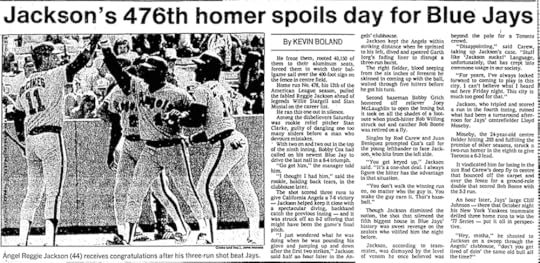
There was still the bottom of the ninth to come, but you just knew it was over. “The Blue Jays had no chance to recover,” wrote Allison Gordon in The Toronto Star. “It wasn’t meant to be.”
Now it was me who was practically shaking, but with anger. Anybody who knows me (and especially those who knew me then) will have no trouble envisioning me stomping around flailing my arms, muttering, “Stupid Reggie! Stupid Blue Jays! Stupid Game! How Could They Blow It!” Which is what I was doing when I fell down the steep flight of stairs that was practically a ladder after taking down the flags from atop the press box a short time later. (I threw down the flags as I was slipping and managed to grab onto the railing and break my fall.)
Getting back to what is sort of the point of this story, because I knew all the stats in those days, I knew that Reggie’s 476th career homer moved him past Stan Musial and Willie Stargell on the all-time list. So, the next day, when I happened to find myself standing beside the cage before the game while Reggie was awaiting his turn for batting practice, I said to him, “Congratulations on passing Stan and Willie, but I’m sure you understand why I’m mad at you.”
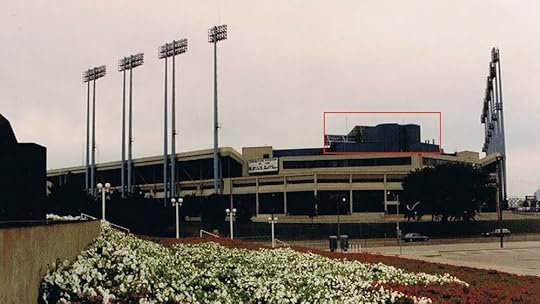
I was up there near the lower part of the red square when I fell …
but I would only have fallen as far as the bottom red line.
He didn’t say anything. Just nodded and smiled a self-satisfied smile. Stupid Reggie!
Oh, and the answer to Jorey’s question: It’s Adrian Beltre.
September 7, 2016
Your Guide to the NHL
The National Hockey League Official Guide & Record Book will be shipped from the printer’s this week. That means it’ll be showing up in bookstores later this month. (If you’re a customer who prefers to purchase it directly from our office, it’s time to send in your email order or click this link to the dda.nhl eBay site.) If you’re a media person who receives The Guide from the NHL, or from Dan Diamond & Associates, you should be getting your copy soon.
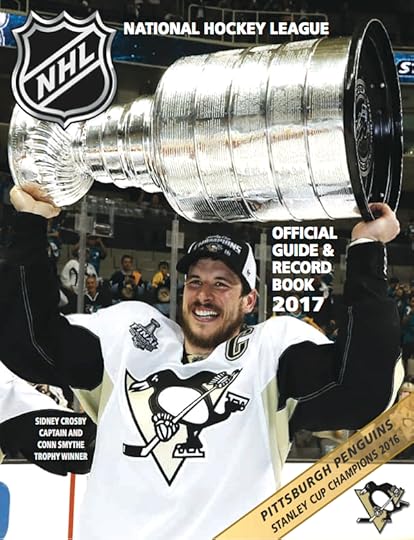
The National Cover
This year marks the 85th edition of The Guide & Record Book, which is pretty impressive – especially when you consider that this season marks the NHL’s 99th anniversary. All of us are certainly hoping to have the opportunity next summer of working on The Guide for the NHL’s 100th anniversary. (For something of a “behind the scenes” story, please have a look at Howard Berger’s photo essay and interview with Dan Diamond published yesterday on Howard’s web site Between the Posts. Scroll down from his top story about the Leafs’ quiet summer.)
As I said in my own story about The Guide last year, we can’t match the up-to-the-minute aspect of the many sports web sites out there these days, but you’ll be hard pressed to find any one site on the Internet that can give you all the information we provide as neatly and concisely as what’s contained in the NHL Official Guide & Record Book. And I dare say you’ll have an even harder time finding one that does so with such attention to detail!
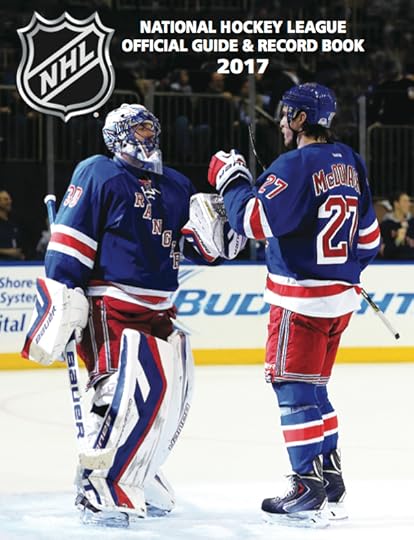
New York Rangers custom cover
In my story last year, I provided a brief history of the NHL Guide and my role with it. I also wrote about how Connor McDavid’s father had helped me to make sure we had Connor’s minor hockey stats correct. Nothing quite as impressive as that this year, but as usual, there were some 40+ people I contacted to make sure we got the stats for some 150 or so new North American Draft choices as accurate as possible. Many of these people have helped out year after year. Others I encountered for the first time this summer.
Among my favourite stories this year involves Adam Vay. Vay wasn’t drafted, but was signed as a free agent by the Minnesota Wild in May. He’s from Budapest, Hungary, and is currently the only Hungarian in The Guide. (The Edmonton Oilers drafted Tamas Groschl of Budapest – who was still playing in Europe last year, although he never made it to the NHL – back in 1999).
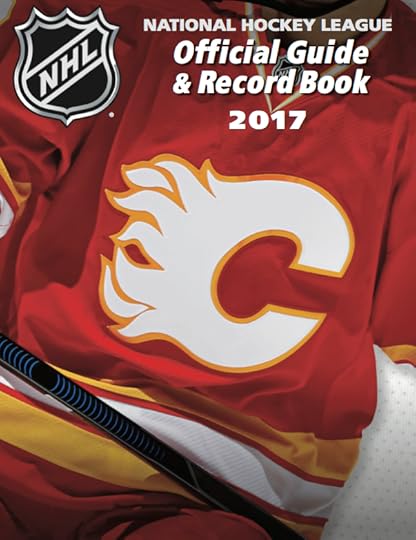
Calgary Flames custom cover
Our International Editor and European expert, Igor Kuperman, was able to confirm the overseas stats for Vay that can be found on many web sites, but I wanted to track down the numbers for the two seasons he spent playing junior hockey – in Texas! – with the El Paso Rhinos of the Western States Hockey League. (Vay, by the way, is one of two players in the Guide to come out of the WSHL; the other being Jeremy Langlois – pronounced LANG-LOYS, not LAN-GWAH because he’s from Tempe, Arizona, not Canada. You’ve probably never heard of Langlois, but he spent the last three seasons in the San Jose Sharks’ system.)
Anyway, the Minnesota Wild did seem to have detailed numbers for Vay in their press release when they announced his signing – but nobody else did. I always like to be able to confirm such things and for whatever reason, a lot of the web sites that are great for minor and junior hockey stats aren’t very good for goalies. They seem to be set up mainly to track goals, assists, points, and penalty minutes, and often only show games and goals-against average for goalies. That was certainly the case with Vay, and the correct Pointstreak site that should have had the full numbers for the Western States Hockey League from past seasons was proving difficult to find.
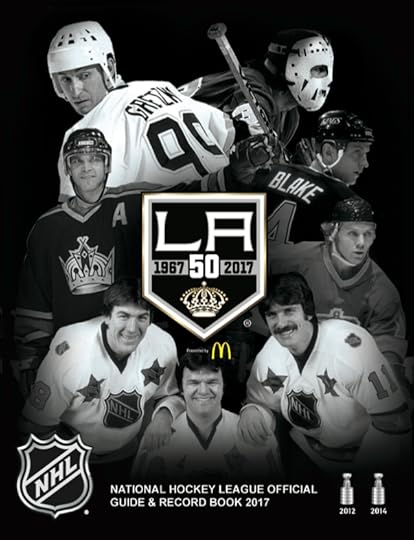
Los Angeles Kings custom cover
It’s not always easy to get a hold of hockey people in the summer. That’s often a frustration in our job. So, I can’t say I was expecting much when, late on a Monday afternoon in early August, I called the office of the El Paso Rhinos. Much to my surprise, a young woman (who can’t possibly be as young as she sounded!) answered the phone. She’s the team’s Assistant Director of Hockey Operations, and was able to direct me to exactly where I needed to go to find Vay’s complete stats for his two seasons with the team. (The Wild had it right, by the way!)
“How does a kid from Budapest find his way to El Paso?” I asked.
“We have scouts all over Europe,” she said.
Who knew?!?

Adam Vay in action with the El Paso Rhinos. For more on his story, click here.
Vay’s not likely to make the kind of impact in Minnesota this season that Connor McDavid has made in Edmonton. In fact, after spending last year back in Hungary, he may well find himself with the Wild’s American Hockey League farm club in Des Moines, Iowa, or even their ECHL team in Moline, Illinois. But I’ll certainly be watching to see if and when he makes it to the NHL!
August 23, 2016
Olympic Memories
I wasn’t that excited this year before the Olympics started. Probably all the negative reports about conditions in Rio. I don’t know. But then, once it got going, there I was, tuning in every night. I’m sure the strong Canadian performance had a lot to do with it. Penny Oleksiak and the rest of the swimmers; Andre De Grasse and the Canadian track team. But it wasn’t just the Canadians. Watching the young Brazilian duel with the French champion in men’s pole vault was amazingly exciting. Who knew?
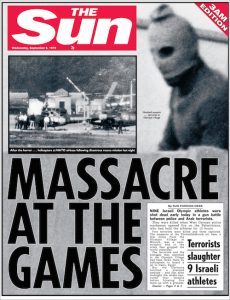 My earliest Olympic memories are from Munich in 1972. I was still only eight years old; a little under two months away from my ninth birthday. I can’t really remember how much I saw. I was certainly aware of the hostage-taking and eventual murder of the Israeli athletes. And I knew Mark Spitz won seven gold medals. Pretty sure I saw at least one of his races. Probably on Channel 7, ABC from Buffalo, with Jim McKay hosting.
My earliest Olympic memories are from Munich in 1972. I was still only eight years old; a little under two months away from my ninth birthday. I can’t really remember how much I saw. I was certainly aware of the hostage-taking and eventual murder of the Israeli athletes. And I knew Mark Spitz won seven gold medals. Pretty sure I saw at least one of his races. Probably on Channel 7, ABC from Buffalo, with Jim McKay hosting.
The Munich Games ran from August 26 to September 11, 1972. My grandfather died that August 26. Team Canada and the Soviets played all four Canadian games of the Summit Series between September 2 and September 8. All three of those incidents seem so separate and distinct to me. Funny how our memories work.
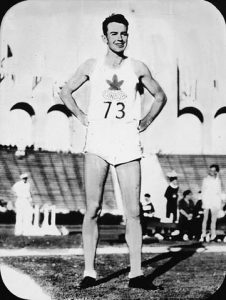 I used to have an infallible memory. Never forgot a thing! Not so any longer now that I’m on the other side of 50. I’m still pretty good, but there’s just way too much, “You know… That guy… With the thing… We saw him in that movie the other night…” (Strange thing is, when I heard that a Canadian won a gold medal in the high jump at Rio, I knew right away that the last Canadian to win it was Duncan McNaughton in 1932, but without looking it up, I honestly can’t tell you the name of this year’s guy!)
I used to have an infallible memory. Never forgot a thing! Not so any longer now that I’m on the other side of 50. I’m still pretty good, but there’s just way too much, “You know… That guy… With the thing… We saw him in that movie the other night…” (Strange thing is, when I heard that a Canadian won a gold medal in the high jump at Rio, I knew right away that the last Canadian to win it was Duncan McNaughton in 1932, but without looking it up, I honestly can’t tell you the name of this year’s guy!)
It’s funny what I remember about the 1976 Olympics in Montreal. Yes, I know Nadia Comaneci was the star with those perfect 10s in gymnastics, but I’m not sure I ever saw her perform. Pretty sure I did see Greg Joy win silver in the high jump, but I may be mixing that up with how many times I’ve seen it since! Then again, I have very distinct memories of U.S. gold medalist Dwight Stones, so I must have been watching. I also remember Lasse Viren winning double gold in the 5,000 and 10,000 meters (which he had done previously in Munich). But what I remember best from Montreal in 1976 is Cindy Shatto in platform diving.
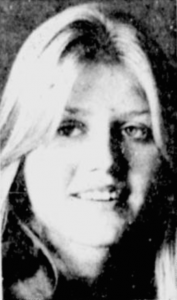 I’m not sure why. It may be because she was the daughter of Toronto Argos legend Dick Shatto … but he had retired long before I started watching football. It could be because she was 19 and pretty and I was a 12-year-old boy. (Legendary Vancouver sportswriter Jim Taylor once wrote, “the Canadian diving championships caper was a bonanza for girl-watchers because when Cindy Shatto walked by, you had to book space to fall into the pool.”)
I’m not sure why. It may be because she was the daughter of Toronto Argos legend Dick Shatto … but he had retired long before I started watching football. It could be because she was 19 and pretty and I was a 12-year-old boy. (Legendary Vancouver sportswriter Jim Taylor once wrote, “the Canadian diving championships caper was a bonanza for girl-watchers because when Cindy Shatto walked by, you had to book space to fall into the pool.”)
Shatto finished fifth and out of the medals in platform diving at Montreal in 1976. Our whole family was watching (or at least, my dad and I were) and I remember fans booing the judges as she fell out of second place in the second half of the competition. I expected to see a lot more about that when I looked up the stories from that night. The Gazette in Montreal said nothing about the controversy, quoting Shatto as saying: “I feel all right. Just about what I expected.”
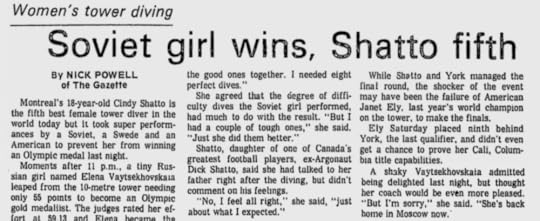
Montreal Gazette, July 26, 1976.
The Globe and Mail in Toronto had even less to say about it. It was almost enough to make me doubt my memories, but the Toronto Star told it the way I recall. “Shatto had been second at the half-way mark of the eight-dive contest,” wrote Len Coates, “but slipped back on some questionable decisions by judges, who were loudly booed by a crowd estimated at 5,000.”
“Some of it was good, some was terrible,” said Shatto of the judging. “Some dives I saw got way more than they deserved and some got way less… [but] fifth in the world isn’t too bad. I can’t complain.”
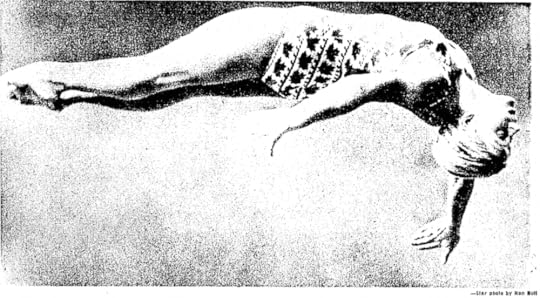
Shatto was more open about her feelings in Paul Patton’s Where Are They Now Column in the Globe and Mail in 1987. Back in 1976, countries with divers in the finals also were allowed to have judges handling the scoring. “There was a lot of controversy about that and they changed the rules after,” Shatto said. “It was won by a Soviet but they say I should have gotten a bronze or a silver. Finishing fifth was a disappointment. I had worked so hard for the Olympics. I was peaking at the right time. This meant everything to me and I had put my whole life into diving.”
I didn’t know it until I was writing this story, but Cindy Shatto died of lung cancer back in 2011. She was only 54.



